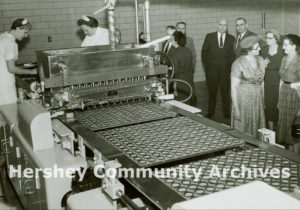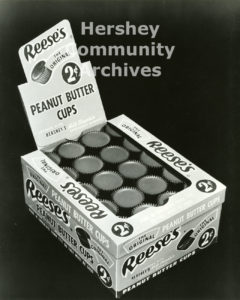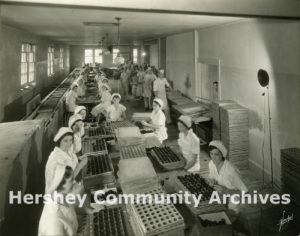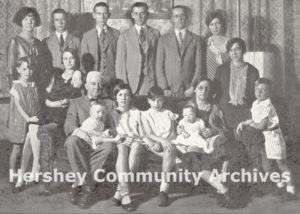H.B. Reese Candy Company

Harry Burnett Reese, founder of the H.B. Reese Candy Company, was born in Frosty Hill, Pennsylvania (York County) on May 24, 1879. In 1900, H.B. Reese married Blanche Edna Hyson, daughter of a well to do family in Bridgeton (York County), Pennsylvania. H.B. and Blanche would eventually have 16 children (8 girls, 8 boys), 13 of whom survived to adulthood.
H.B. Reese moved frequently during the first couple decades of the 20th century as he sought a career that would fulfill him and support his growing family. He began his working life as a farmer on his farm, Frosty Hill, located near Muddy Creek Forks, Pennsylvania. Not fond of farming, he moved his family to Ditchley, Virginia in 1903 to manage the fishing operations of his father-in-law’s cannery business. After four years he and his family returned to Frosty Hill and Reese resumed farming. In 1912, H.B. Reese moved his family to a dairy farm in Woodbine, located near his father-in-law’s general store.
When the oldest Reese children became old enough for high school, H.B. Reese moved the family to Shrewsbury, Pennsylvania and took a factory job in New Freedom so that they could attend high school.
In about 1916, H.B. Reese read an advertisement for dairy farmers in Hershey. The next year he moved his family to Hershey to take a job as a dairyman, first working on Farm 28-A. In 1918, Reese was promoted and moved to manage the Round Barn [which was located near present day Hersheypark Drive]. Reese managed the Round Barn until it was shut down as a cost saving measure in 1919. Needing work, Reese decided to start his own candy business in nearby Hummelstown, Pennsylvania. The new business, R & R Candy Company began producing chocolate covered almonds and raisins. The local paper, The Hummelstown Sun, included announcements about the new venture. In spite of his best efforts the business failed. Reese next took a job at a Spring Grove, Pennsylvania paper mill owned by W.L. Glafelter. Money was tight and Reese took on second and sometimes third jobs to support his family. The stay in Spring Grove was brief and the Reese family returned to Hershey in time for their daughter, Rose Amos, to be born in early 1921. To help his daughter and son-in-law, H.B. Reese’s father-in-law purchased a home at 18 E. Areba Avenue for the ever expanding family. With this return to Hershey, Reese began working at the Hershey Chocolate factory in the shipping room. Money was tight and several of the Reese children also worked to help support the family.
The bright idea, however, which inspired H.B. Reese to venture into the candy business, was sparked while he worked on one of the Hershey Chocolate Company dairy farms. “If Hershey can sell a trainload of chocolate every day,” H.B. Reese reasoned, “I can at least make a living making candy.” As soon as he was financially able to buy the ingredients, Reese began making candy in the basement of the Areba Avenue house. He made a variety of confectionery products including hard candies, chocolate covered nuts and raisins, mints and an invented chocolate covered caramel-coconut candy, the “Lizzie Bar,” named for his oldest daughter, Mary Elizabeth. That bar was soon followed by the “Johnny Bar,” named for a son. He enjoyed enough success to quit his steady job in the factory and set out to “make a living” by making candy.
As sales increased, Reese expanded, renting the basement of the DeAngelis building on Chocolate Avenue [today the location of Fenicci’s Restaurant]. By 1925, Reese needed to expand again and built a factory and house on the corner of Ridge Road and Caracas Avenue. The buildings were completed in early 1926. The Reese home was finally large enough to accommodate the family. H.B. Reese used his impressive family as a marketing tool. In 1928, a photograph of the entire family with the caption, “16 Good Reasons to Buy Reese’s,” was used in a variety of advertisements.
He began making his famed Peanut Butter Cups as part of a large candy assortment about 1928. Besides the Peanut Butter Cup, the assortment line included: coconut cream, peppermint cream, chocolate jets, nougat, marshmellow-nut, coated dates, coconut caramel, peanut clusters, raisin clusters, honey dew coconut and nuttees. The candy was coated by hand on marble slabs, four ladies at each table. The candy was packed in five pound boxes and sold to department stores for re-sale by bulk weight. To promote sales H.B. Reese often set up a coating table in the windows of large department stores and had several girls coating the candy in full view of passing shoppers. Inside the store, other girls would hand out samples.
The early years of the Depression were a financial struggle. During the summer months when it was too hot to make candy, H.B. Reese operated a truck farm and hired workers to pick green beans and other vegetables. Reese put his canning experience to use and set up a canning business to process the produce grown at area farms.
The company began to take off in the mid 1930s. Peanut Butter Cups were the company’s most popular product. About 1935, Reese began marketing the Peanut Butter Cup as a separate item, individually packaging it in $0.05 packs. Peanut Butter Cups were also marketed in several sizes including a 1 cent, 2 cent and 5 cent size. In 1942, due to wartime rationing and the popularity of the Peanut Butter Cup, H.B. Reese discontinued all other product lines and focused his efforts on the Peanut Butter Cup.
Since the beginning, the company enjoyed a close relationship with Hershey Chocolate and Hershey supplied all of Reese’s chocolate coating. H.B. Reese promoted the company’s connection in advertising and on packaging. Each Peanut Butter Cup package carried the banner: “Made in Chocolate Town –So They Must Be Good.”
Reese encouraged a sense of family among his employees. Around 1935, H.B. Reese built a fishing lodge on the Eastern Shore of Maryland. The spacious lodge was open to all Reese employees at the cost of a dollar a day, all meals and lodging included. There are many fond memories passed down of weekends at the Lodge, fishing in the bay and enjoying bountiful and delicious meals.
H.B. Reese Candy Company continued to enjoy success during the post war years. Company growth led to the need for more manufacturing space and in 1957 a new and modern manufacturing facility on West Chocolate Ave opened. Unfortunately, H.B. Reese did not live to see the factory completed. He died on May 16, 1956, and was succeeded by his six sons. (John M. Reese served as president of the firm; Robert H., treasurer; Ralph C., secretary; Edward I., vice-president; Harry B., Jr., traffic manager; C. Richard, sales manager.) In 1963, the company was sold to Hershey Chocolate Corporation.


